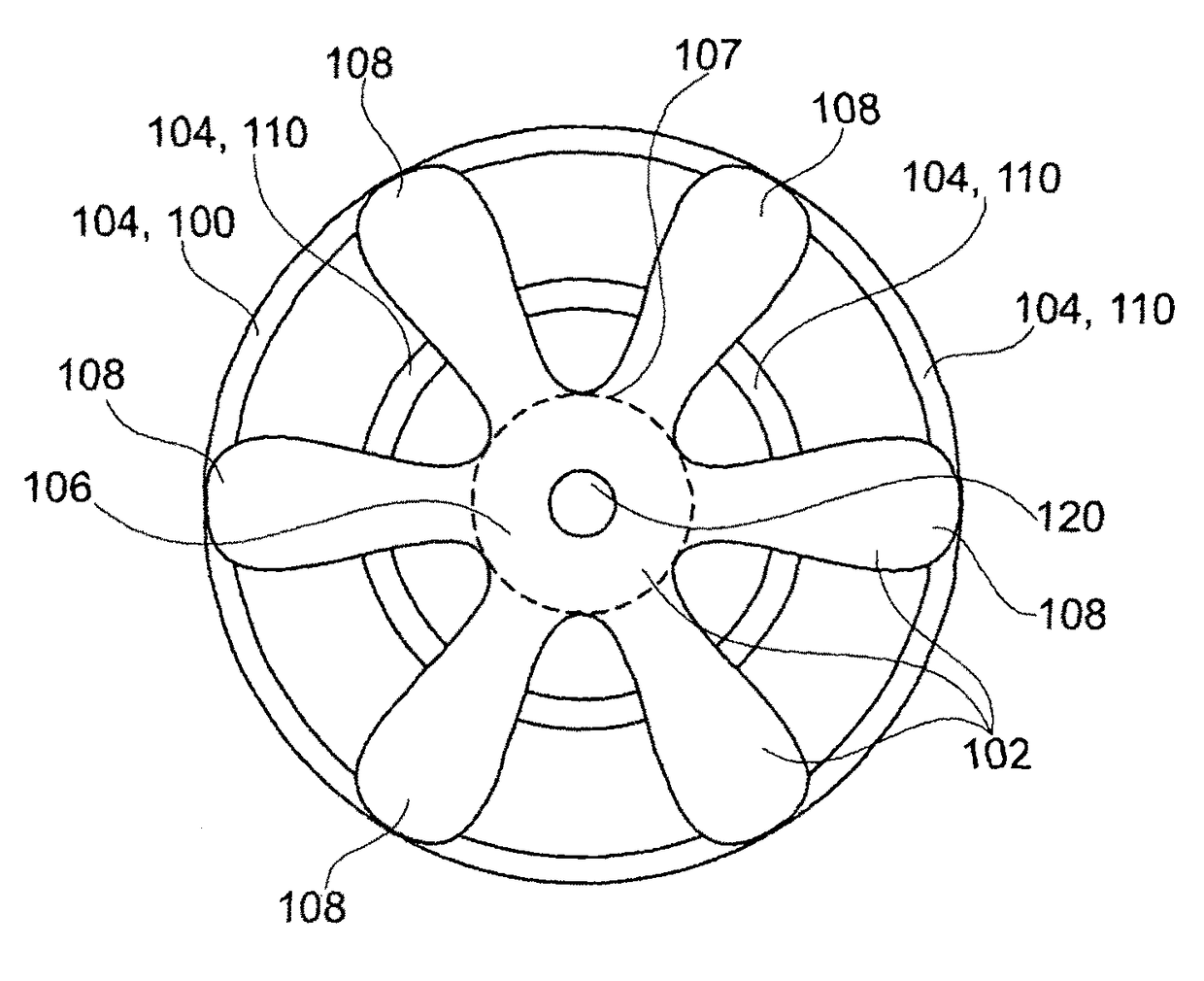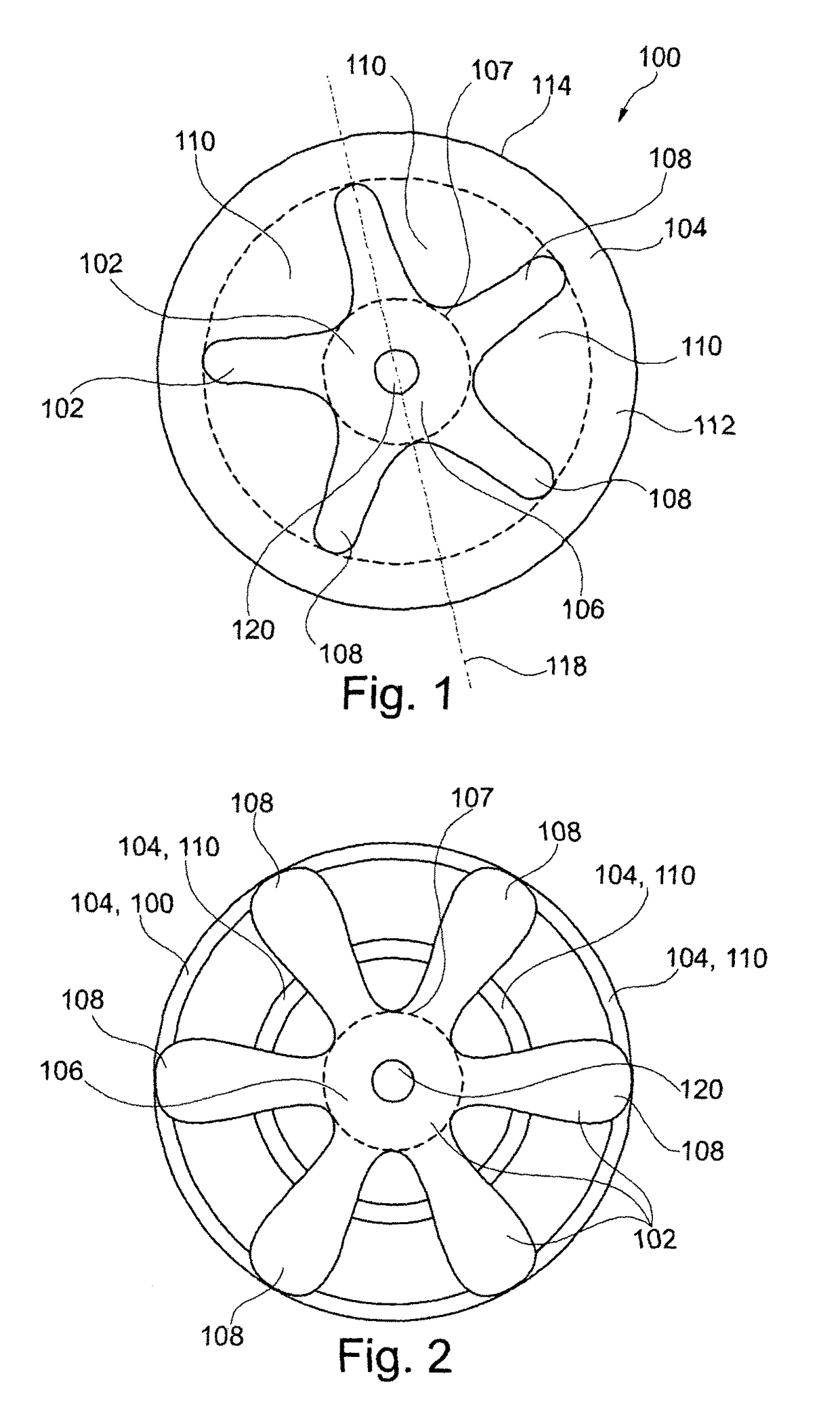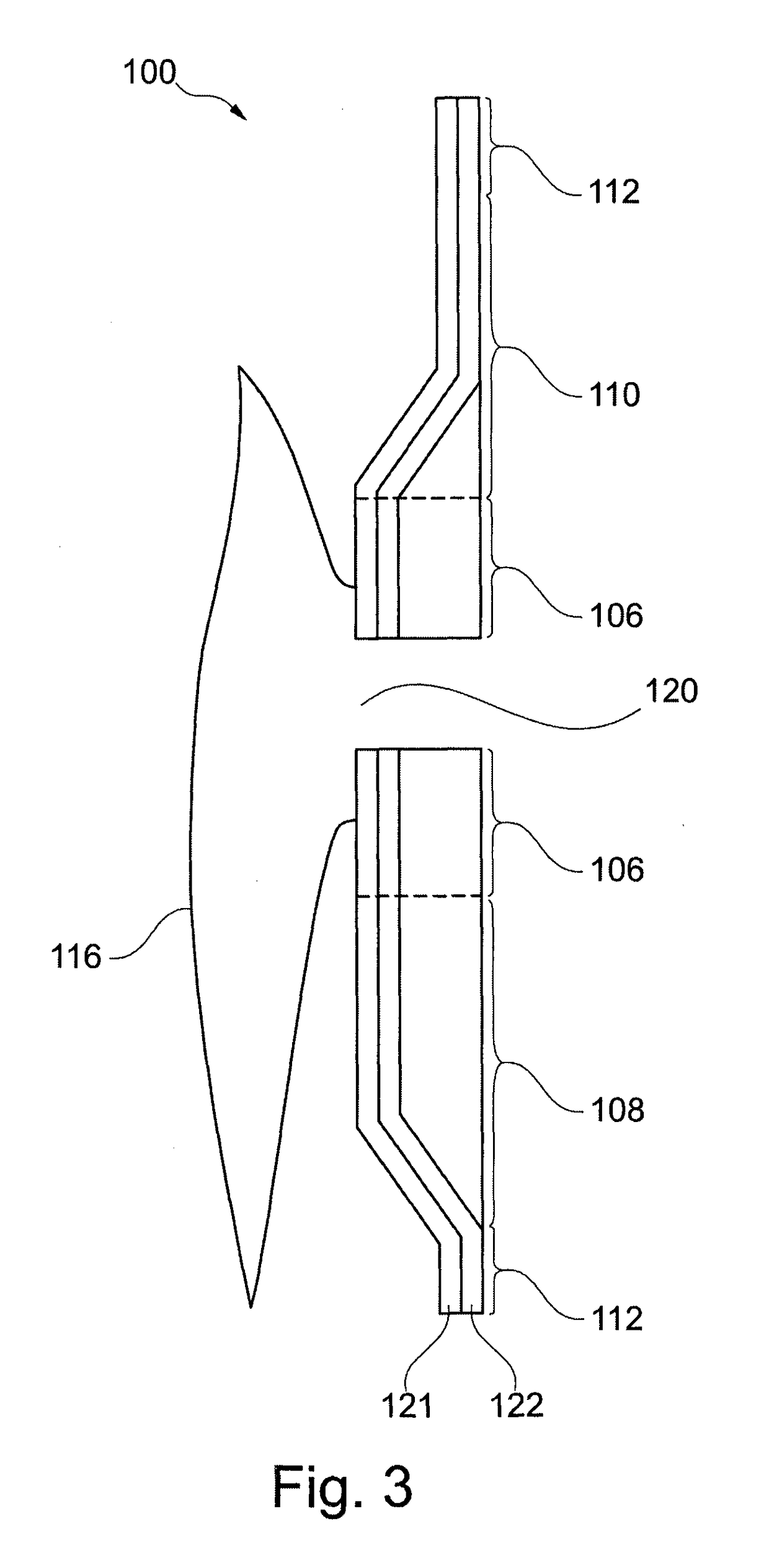Ostomy appliance
a technology for ostomy appliances and adhesive wafers, applied in the field of ostomy appliances, can solve the problems of time-consuming and cumbersome removal of adhesive wafers, non-rounded adhesive wafers of ostomy appliances, and adhesive wafers
Active Publication Date: 2017-04-18
COLOPLAST AS
View PDF25 Cites 16 Cited by
- Summary
- Abstract
- Description
- Claims
- Application Information
AI Technical Summary
Benefits of technology
[0010]One advantage of the present invention is that two neighboring radially extending zones which are interconnected by an interconnecting part may be removed in one and the same motion. The reason for this being that detachment of one of the two radially extending zones will cause the interconnecting part to be detached and thus also the other of the two radially extending zones. Thus, the wafer of the invention is able to provide a better fit to curved body surfaces due to the presence of the radially extending portions, such as a protruding stoma, but is at the same time easy to detach from the skin after use.
[0012]Compared to a traditional adhesive wafer which is round or rounded (e.g. circular or oval), the provision of a combination of radially extending zones and interconnecting parts provides for an adhesive wafer which may be easier to attach to the skin of the user. As an example, the radially extending zones may have a first property while the interconnecting parts may have another property, such as being more flexible. Thus, it may be easier for the user to customize the adhesive wafer to the 3D-geometry of the peristomal area, such as in cases where the stoma is associated with a hernia. Preferably, the radially extending zones will together with the interconnecting parts provide a wafer having a substantially round outline. By substantially round outline is herein meant that the outline is circular or oval, not necessarily strictly symmetrical, but is having a pronounced rounded shape without distinct deviations. However, the wafer, a non-adhesive tab member, may be present at the rim of the wafer in order to ease initial grip during detachment of the wafer.
[0041]In yet another embodiment, the yield strength of the second zone is lower than the yield strength of the first zone. The effect is that the second zone—which defines the interconnecting parts—may easily be stretched relative to the first zone which defines the radially extending zones. This provides the user with the advantage that it is easier to adapt the geometry of the adhesive wafer to the geometry of the user—which is especially advantageous for example in cases where a hernia is associated with the stoma.
[0042]Another example of different properties of the first and the second zone is the stiffness. Accordingly, the stiffness of the first zone may be larger than the stiffness of the second zone. One advantage of providing stiffer first zones is that the radially extending zones will be stiffer than the interconnecting parts. This may make it easier to remove the adhesive wafer from the skin of the user as the user may disengage the adhesive wafer from the skin by peeling off the relatively stiff radially extending parts. As these radially extending parts are interconnected by means of the interconnecting parts, the adhesive wafer may be removed in one single motion. When the second zones are less stiff than the radially extending zones, it may be easier for the user to fasten the adhesive wafer to the skin of the user. This is especially the case when the second zones are more flexible than the radially extending zones. Moreover, an adhesive wafer with stiff zones and less stiff zones may be more comfortable to wear as the less stiff zones may allow the stiffer zones to move easily relative to each other e.g. when the user bends the stomach.
[0044]The first and the second zones may comprise different adhesives, for example a soft adhesive and a stiffer adhesive or adhesives with different absorption properties. The different adhesive may be combined with different thicknesses in order to enhance the difference in properties.
[0047]The second zone may be very thin and flexible. When applying the wafer to a protruding surface such as a hernia or an inward stoma the radially extending zones may be applied without wrinkles and any surplus of the wafer in the interconnecting second zone may be crinkled, crumbled to fit. If the second zone is thin and flexible, any folds and crinkles will be very small and flat and does not give rise to leakages or friction, but on the contrary provide a snug fit to the skin.
Problems solved by technology
Ostomy appliances with non-rounded adhesive wafers have the disadvantage that each of radially extending parts of the adhesive wafer must be detached separately in order to remove the entire adhesive wafer.
This causes removal of such adhesive wafers to be time consuming and cumbersome.
Method used
the structure of the environmentally friendly knitted fabric provided by the present invention; figure 2 Flow chart of the yarn wrapping machine for environmentally friendly knitted fabrics and storage devices; image 3 Is the parameter map of the yarn covering machine
View moreImage
Smart Image Click on the blue labels to locate them in the text.
Smart ImageViewing Examples
Examples
Experimental program
Comparison scheme
Effect test
first embodiment
[0056]FIG. 1 discloses the adhesive wafer,
second embodiment
[0057]FIG. 2 discloses the adhesive wafer, and
[0058]FIG. 3 discloses an ostomy appliance according to the present invention.
the structure of the environmentally friendly knitted fabric provided by the present invention; figure 2 Flow chart of the yarn wrapping machine for environmentally friendly knitted fabrics and storage devices; image 3 Is the parameter map of the yarn covering machine
Login to view more PUM
 Login to view more
Login to view more Abstract
An ostomy appliance for attachment to a stoma, the ostomy appliance comprising: an adhesive wafer (100) defining a passage for receiving a stoma of a user, the adhesive wafer comprising a backing layer and a skin facing adhesive layer; and a collecting bag (116) which in use is secured to the adhesive wafer; wherein the adhesive wafer in a first adhesive zone has a first set of properties and in a second adhesive zone (104) has a second set of properties, the first zone defining three or more radially extending zones, wherein the second zone defines one or more interconnecting parts (110), each of which interconnects at least two of the radially extending zones (108).
Description
FIELD OF THE INVENTION[0001]The present invention relates to an ostomy appliance comprising an adhesive wafer defining a first and a second zone. The first zone defines three or more radially extending zones, at least two of which are interconnected by interconnecting parts.BACKGROUND OF THE INVENTION[0002]Ostomy appliances with non-rounded adhesive wafers have the disadvantage that each of radially extending parts of the adhesive wafer must be detached separately in order to remove the entire adhesive wafer. This causes removal of such adhesive wafers to be time consuming and cumbersome.[0003]It is an object of one or more embodiments of the present invention to provide an ostomy appliance which overcomes this problem.DESCRIPTION OF THE INVENTION[0004]In a first aspect, the present invention relates to an ostomy appliance for attachment to a stoma, the ostomy appliance comprising:[0005]an adhesive wafer defining a passage for receiving a stoma of a user, the adhesive wafer comprisi...
Claims
the structure of the environmentally friendly knitted fabric provided by the present invention; figure 2 Flow chart of the yarn wrapping machine for environmentally friendly knitted fabrics and storage devices; image 3 Is the parameter map of the yarn covering machine
Login to view more Application Information
Patent Timeline
 Login to view more
Login to view more Patent Type & Authority Patents(United States)
IPC IPC(8): A61F5/443A61F5/448A61F13/15A61F5/449
CPCA61F5/443A61F5/448A61F13/15211A61F2005/4495Y10T428/24Y10T428/24273
Inventor ISRAELSON, DORRIT DIANABUUS, HASSEKLEIN, CHARLOTTEHANSEN, KRISTOFFEREDVARDSEN, HENRIK
Owner COLOPLAST AS
Who we serve
- R&D Engineer
- R&D Manager
- IP Professional
Why Eureka
- Industry Leading Data Capabilities
- Powerful AI technology
- Patent DNA Extraction
Social media
Try Eureka
Browse by: Latest US Patents, China's latest patents, Technical Efficacy Thesaurus, Application Domain, Technology Topic.
© 2024 PatSnap. All rights reserved.Legal|Privacy policy|Modern Slavery Act Transparency Statement|Sitemap



